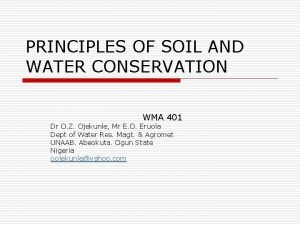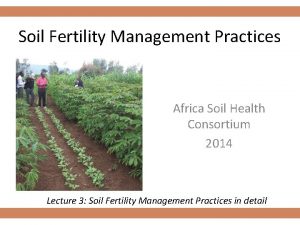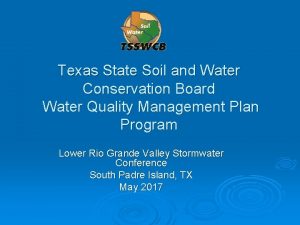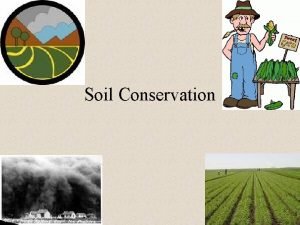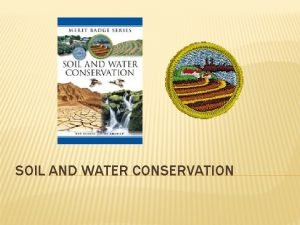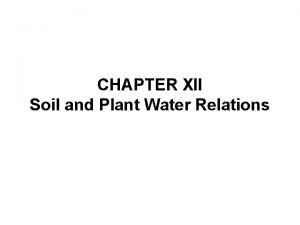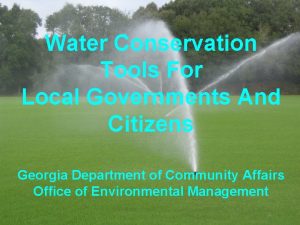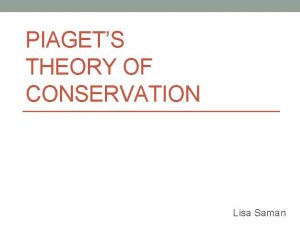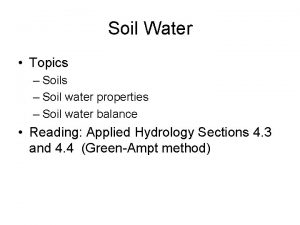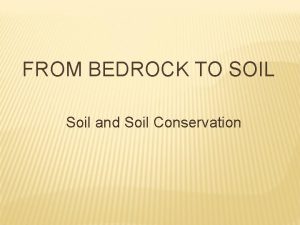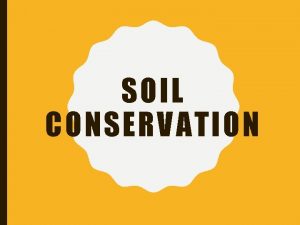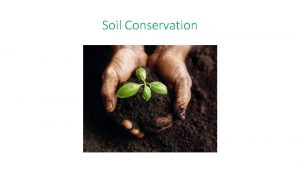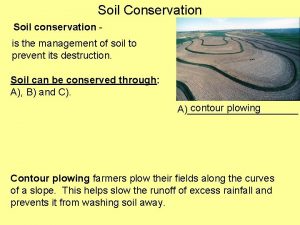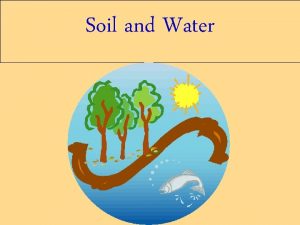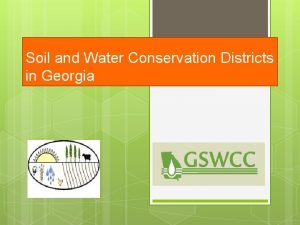Soil Conservation and Water Conservation Soil and water
















- Slides: 16

Soil Conservation and Water Conservation

• Soil and water conservation practice contribute high in the long term agricultural sustainability and sustainable agricultural farming. • Land degradation is a major problem that requires urgent intervention measures. This is especially true in the poorest countries, where agricultural production is crucial to development, and the livelihoods of the majority of the population depend on the primary sector. • According to UNCCD (2004), six million hectares of productive land was being lost globally every year since 1990, due to land degradation.

• In order to mitigate climate change, water shortages, worsening soil conditions, and drought and desertification, promotion of soil and water conservation technologies have been suggested as a key adaptation strategy for countries in the developing world. • The major agronomic soil and water conservations practices are: • Strip cropping, mixed cropping, intercropping, fallowing • mulching, contour ploughing, crop rotation, conservation tillage, and agroforestry.

1. Strip Cropping • It is a kind of agronomical practice, in which ordinary crops are planted or grown in form of relatively narrow strips across the land slope (Figure 1). These strips are so arranged, that the strips crops should always be separated by strips of close-growing and erosion resistance crops. Strip cropping checks the surface runoff and forces them to infiltrate into the soil, which facilitates the concentration of rainwater.

Fig. Strip Cropping

2. Mixed/Intercropping • Intercropping is the cultivation of two or more crops at the same time in the same field. A wide range of crops can be used for intercropping. Mixed cropping of different crops along with the main crops, such as millets and different legumes, is an insurance against the climate change. The different root systems of mixed crop feed at different depths of the soil. Moreover, mixing cropping provides small quantities of a grain of different kinds of home consumption at different times.

Fig. Mixed/Intercropping

3. Mulching • Mulches are ground covers that prevent the soil from being washed away, reduce evaporation, increase infiltration, and control growth of unwanted weeds (Deborah, 2003). Mulch can be organic crop residue, pebbles, or materials such as polythene sheets. Mulching prevents the formation of the hard crust after each rain. Organic mulches add plant nutrients to the soil upon decomposition.

Fig. Mulching

4. Conservation Tillage • Is any method of soil cultivation that leaves the previous year's crop residue on fields before and after planting the next crop to reduce soil erosion and runoff, as well as other benefits such as carbon sequestration. • The method tries to reduce labor in land preparation through tillage systems that promote soil fertility and soil water conservation.

Fig. Conservation Tillage

5. Crop Rotation • It involves alternating cereal crops with legume, pulse or oilseed crops. This type of rotation produces differing amounts and types of residue thus make crop residue and trash management easier. Therefore, a rotation is the key to success in reduced tillage systems, reduces soil erosion and then climate change adaptation.

Fig. Crop Rotation

6. Agroforestry (AF) • It refers to a system of land uses in that there are different trees or shrubs are grown in association with different agricultural crops, pastures or livestock. • In relation to this, one of the most important feature of AF is that there are both ecological and economic interactions between the trees and other components such nature of integration of trees and shrubs in the land-use system can be either a spatial arrangement, or in a time sequence, e. g. trees growing in a field at the same time as a crop, or shrubs grew on a fallow for restoration of soil fertility.

• As it is known, soil and water conservation is not only to indicate keeping the soil in its place from erosion but also to maintain the soil fertility. • Therefore, in soil and water conservation point of view agronomic practices provide a protective role. This is by its prevention of soil from loss by its plant canopy, litter effect, and reduction of velocity of runoff mechanically by runoff barrier function • There always strong links between measures for soil conservation and measures for water conservation, and this applies equally in semi-arid areas. • Similarly, reducing erosion will usually involve preventing splash erosion, or formation of crusts, or breakdown of structure, all of which will increase infiltration, and so help the water conservation.

Improved Water Use Efficiency • Other desirable characteristics are a short growing season, drought resistance, and drought avoidance. The latter means the ability of the plant to adjust its growth habit according to the available moisture, for example, by tillering when moisture is available or going dormant when moisture is short, or only carrying through to ripening a proportion of the seed heads available. • Supplementary irrigation can be important because the provision of small quantities of water at critical times can have good results, for example to allow earlier planting, life-saving irrigation to carry crops through dry periods, or to increase the availability of soluble plant nutrients.
 Water conservation objectives
Water conservation objectives Africa soil health consortium
Africa soil health consortium Texas state soil and water conservation board
Texas state soil and water conservation board Water and water and water water
Water and water and water water Soil conservation and domestic allotment act
Soil conservation and domestic allotment act Soil conservation and domestic allotment act
Soil conservation and domestic allotment act Soil conservation and domestic allotment act
Soil conservation and domestic allotment act Hepscd
Hepscd Soil conservation
Soil conservation Explain water pollution
Explain water pollution Living soil vs dead soil
Living soil vs dead soil Four major spheres of the earth
Four major spheres of the earth Soil and water relationship
Soil and water relationship Water conservation tools
Water conservation tools Piaget water conservation age
Piaget water conservation age Preoperational reasoning stage
Preoperational reasoning stage Concrete operational stage
Concrete operational stage
